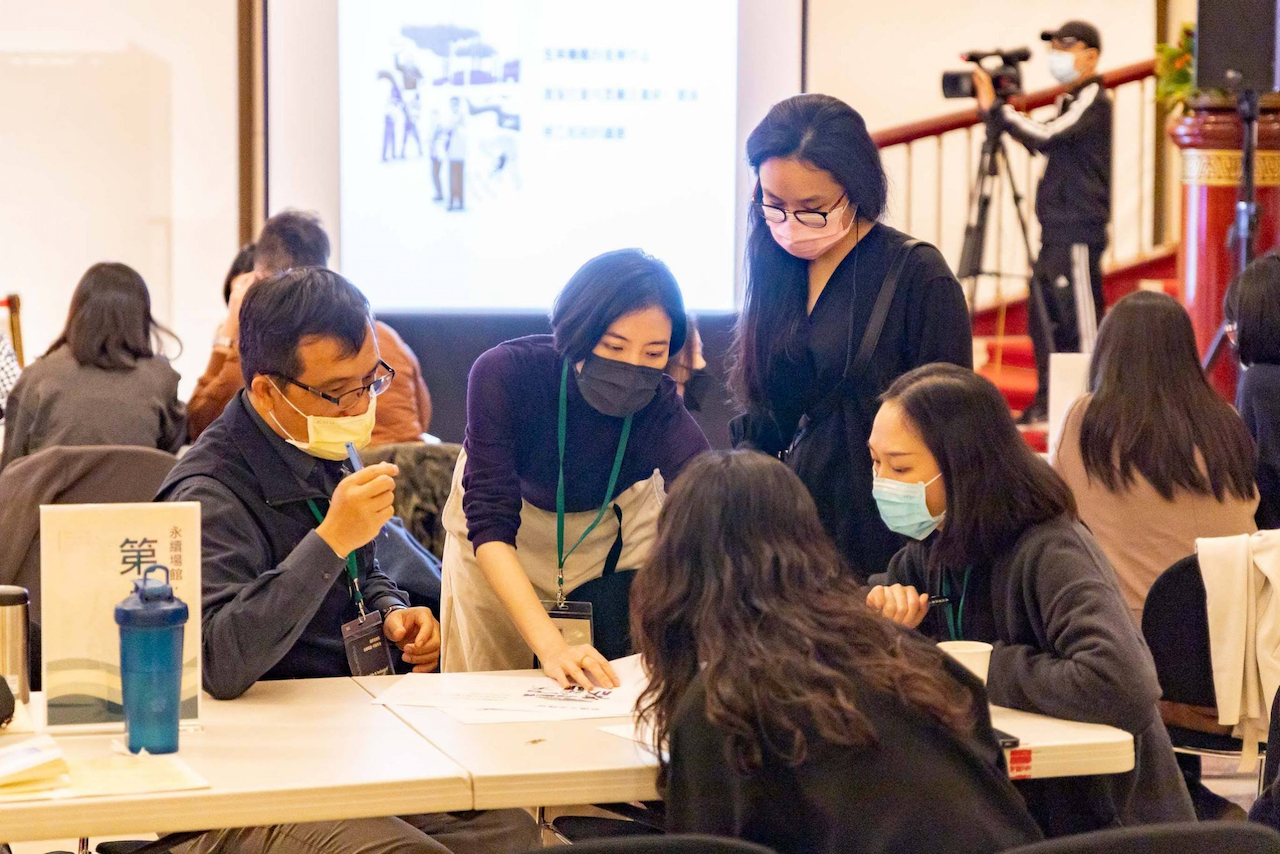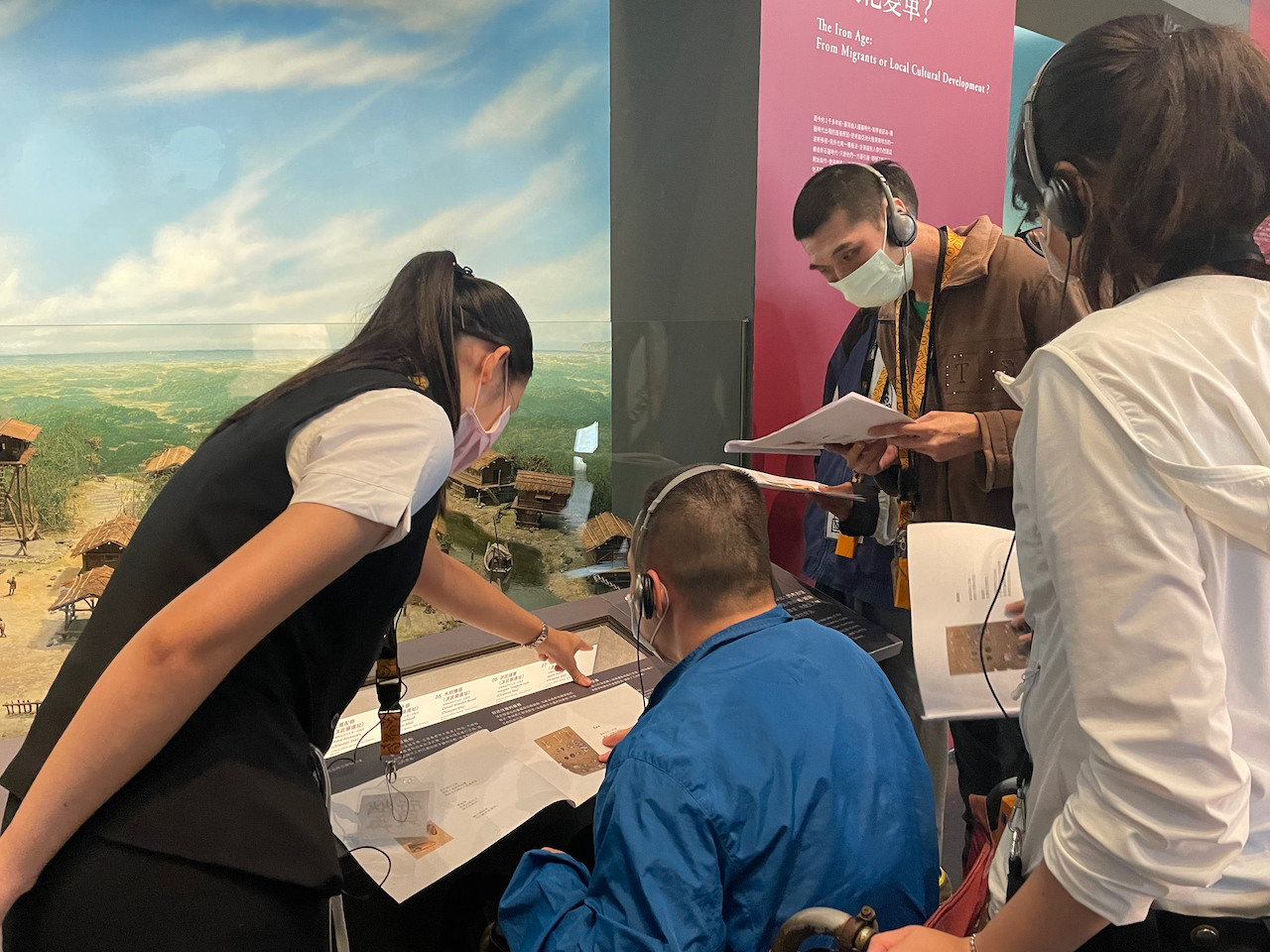文富和亞魁都是參與審議故宮易讀導覽手冊的心智障礙者青年(簡稱青年或障礙者)。他們不只透過手冊上的故事認識故宮的文物,更進一步在審議會議上,提供修改圖文的建議,讓手冊使用上更為易讀易懂。
 青年們使用易讀版導覽手冊《走進銅話世界:青銅篇》參訪國立故宮博物院。圖/三明治工提供
青年們使用易讀版導覽手冊《走進銅話世界:青銅篇》參訪國立故宮博物院。圖/三明治工提供
許多家長希望孩子們變「好」、變得像多數人一樣「正常、健全」。這種思維可追溯到早期的醫療模式(medical model)。在這種模式下,大眾、專家和家長們均試圖矯正障礙者,喚起社會的憐憫,卻忽略了他們身而為人的本質和與生俱來的獨特性。即便是到了2022年的今天,多數人的想法依舊充滿偏見,認為障礙者「很可憐」,需要「被拯救」。
認為心智障礙者完全沒有理解的能力,就是偏見之一。
我們希望任何「障礙」都能被消弭,或可以得到改善,可是日常生活中艱澀的字句、複雜的圖像和圖文連結的不足,考驗的已經不只是障礙者的理解,對許多數人而言,同樣無助於訊息的傳達。因此迫切需要改善的,恐怕是社會上「資訊無障礙」的不足,而非歸咎於青年自身的能力。目前為止,我們耳熟能詳的無障礙服務包括廁所、手語翻譯和點字,多屬「硬體無障礙」,但如何友善地取得及傳達資訊,首先就是更加重要的問題。
「易讀手冊」的服務就是資訊無障礙的一種,也就是將既有的生活資訊、藝文活動和社會福利等訊息,轉譯成簡單易懂的圖文說明。這種服務的主要使用者,正是像文富和亞魁這樣的青年。易讀資訊讓他們能夠更輕鬆地認識多采多姿的世界,降低體驗活動、獨立思考和親自做出選擇的門檻。
 國家兩廳院易讀導覽手冊審議會討論細部草圖。圖/三明治工提供
國家兩廳院易讀導覽手冊審議會討論細部草圖。圖/三明治工提供
 編輯易讀手冊的重點之一是邀請障礙者們以委員的身分參與討論,圖為國家兩廳院易讀導覽手冊審議會討論過程。圖/三明治工提供
編輯易讀手冊的重點之一是邀請障礙者們以委員的身分參與討論,圖為國家兩廳院易讀導覽手冊審議會討論過程。圖/三明治工提供
邁向無障礙社會,「資訊無障礙」只是第一步,青年也能共同編修或審議手冊的「障礙者參與」則是第二步。
事實上,在青年參與的審議會中,他們往往能自由表達想法,主動分享生活經驗,針對特定主題提出一套獨到的見解。審議委員秀貞看了看手冊草稿,就曾直率地說:「我不喜歡這幾句話,『幫忙我們』讓我覺得我很弱,我喜歡用『支持』。」這樣的想法不是憑空而來,而是有賴多年來中華民國智障者家長總會(簡稱智總)建立青年自立生活和自我倡議的努力。
審議會議邀請障礙者們以委員的身分參與,是編輯易讀手冊的重點之一。會議上,青年分別針對文句和插圖草稿提出修改建議,手冊不再是企劃者單方面執行或設計即告完成,是否採納使用者的意見更是重要。整份易讀手冊的編輯過程必須是參與式的。
這個參與式的共構過程,是為了設身處地為使用者著想,共議出更合適的替代詞來修飾既有字詞,青年們會進行簡單的投票。但是,這個民主常見的流程只是觸發大家進一步討論的契機。「我知道『詭異』是什麼意思,但我覺得『奇怪』會是更多人能理解的。」字詞的分析、討論和最終的替換,是青年們互動的結果,而這樣的慣例,更是在他們明瞭身為委員的責任和同理他人的長期過程中確立下來的。
值得注意的是,青年們確實付出心力,提供親身經歷讓手冊更加簡明,因此他們是「審議委員」,不是「志工」,有資格領取一定的費用。簽收領據時,有些人會毫不掩飾地透露這筆收入的用途。一位青年領到錢後,便說要捐給中華民國智障者家長總會,希望智總為青年們舉辦的活動可以持續。
最初,三明治工透過藝術計畫跟身心障礙者合作,一起改變大眾認知的障礙者樣貌;一路走來,我們和關注各種議題的非營利組織交流,盡可能用有趣的方式跟社會大眾溝通。
2017年,三明治工製作了團隊的第一本易讀手冊,介紹展覽「大嘻地:公益藝術創作展」(簡稱「大嘻地」)和觀眾在展中與裝置互動的方式。這是一檔連結臺灣和香港非營利組織的共融藝術創作展,參與的創作者大多是心智障礙者。三明治工將他們精彩的創作轉化成彩色裝置,包括火山、小山丘、河川等立體自然景物。這裡充滿各式各樣的珍禽異獸,觀眾可以套上創作者繪製的衣服,穿著特定角色的服飾遊歷展場。
 「大嘻地:公益藝術創作展」立體裝置展出現場。圖/三明治工提供
「大嘻地:公益藝術創作展」立體裝置展出現場。圖/三明治工提供
 「大嘻地:公益藝術創作展」中,樂山教養院小雅和她繪製的衣服。圖/三明治工提供
「大嘻地:公益藝術創作展」中,樂山教養院小雅和她繪製的衣服。圖/三明治工提供
當時的三明治工已成立將近五年。透過行無礙資源推廣協會的介紹,我們發現過去臺灣展覽空間中無障礙服務的不足。一個無障礙的展場,至少應該規劃出適當的動線和適切的視覺觀看高度,而除了空間或硬體的無障礙,資訊無障礙也很重要。
在「大嘻地」展覽中,我們製作了一本易讀性質的導覽手冊,邀請智總和剛從英國返臺的郭惠瑜老師一同合作。
智總是臺灣重要的障礙者倡議組織,支持智能障礙者的生涯發展,也定期舉辦青年的聚會和活動,培養青年自立生活。郭老師曾在英國Change組織擔任四年的志工,該組織是一家以提供易讀服務為主的非營利組織,有專門的易讀插畫設計師,成立迄今已有二十載。Change累積了大量的易讀經驗和資源,將障礙者審議後的插圖或圖片建置成易讀圖庫,需要使用的單位可付費使用,這也是組織主要的收入來源之一。
 「大嘻地:公益藝術創作展」易讀審議會議側拍。圖/三明治工提供
「大嘻地:公益藝術創作展」易讀審議會議側拍。圖/三明治工提供
第一本易讀導覽手冊,是青年們在智總的聚會討論完成的,這樣的模式和流程也慢慢形塑出未來我們舉辦易讀審議會的樣貌。如今重新審視「大嘻地」易讀手冊,不免覺得許多內容有待調整。想來不可思議,這本生澀之作在當時竟成了一點星火,在障礙圈和相關組織逐漸流傳開來,成為日後倡議者向政府建言時最好的樣品,進而影響了不同領域易讀服務的開展。
早期許多障礙者組織會使用簡易的圖文素材和心智障礙者溝通,內容可能是介紹三餐或選出下個月的出遊地點。這些素材往往是網路下載的線稿圖配上同仁的巧思。目前審議會議使用的拍攝同意書,即是承襲自陽明教養院院內使用的易讀版同意書。近年,易讀服務不論在藝文場館還是政府宣導相關生活資訊的應用上,跟過去臺灣提供給心智障礙者的無障礙資訊相比,已有非常顯著的增長。其中因素有許多,這裡只略提兩個。
 2017年《身心障礙者權利公約施行法》(Convention on the Rights of Persons with Disabilities)結論性意見易讀版手冊封面。圖/衛生福利部提供
2017年《身心障礙者權利公約施行法》(Convention on the Rights of Persons with Disabilities)結論性意見易讀版手冊封面。圖/衛生福利部提供
第一個,是2014年臺灣簽署的《身心障礙者權利公約施行法》(Convention on the Rights of Persons with Disabilities,簡稱CRPD)。國際公約的簽立,讓政府部門和地方單位開始盤點既有的軟硬體服務和政策。在四年一次的CRPD國際審查會議上,政府邀請國外專家檢視國內各方面的發展是否已符合身心障礙者權益。
必須特別指出的是,多次參與易讀服務的審議委員昱誠,今年也出席了CRPD國際審查會議。這是第一次青年在公開的國際審查會議中為自己發聲。昱誠建議警察和法官等政府執法人員,應該要認識心智障礙者的理解能力及其受阻的原因,不可因為溝通不良,就輕率逮捕他們。舉凡報案、筆錄和上法院等流程,皆需用心智障礙者瞭解的語言加以說明。接著,昱誠指出,政府應該提供更多使身心障礙者自我選擇的協助,使他們參與自我倡導的會議和社團活動:「我在這些活動裡,可以學到分享自己的經驗、生活上的知識和技巧,學會幫助服務別人、交到朋友以及了解其他障礙者的需要,我覺得很重要。」

在上述會議或活動中,只要有心智障礙者參與,承擔轉譯工作的易讀資訊便不可缺少。易讀手冊確實是一種無障礙資訊的呈現形式,但它實踐了青年參與社會的多種可能性,則是更真實、更長遠的效益。不同主題的易讀手冊,代表了各式權益的討論與參與;有需求的朋友能藉此查看可以申請的生活福利,參觀外縣市博物館,欣賞藝術表演,走出家門投票去。即便擁有了權利,如果沒有相應的無障礙資訊,心智障礙者也無法了解內容,並進一步做出選擇和決定。
第二個易讀服務快速發展的原因,可能是三明治工初期發行的幾本易讀手冊在不同場所皆獲迴響。艱澀的資訊轉譯後更好理解,索取易讀手冊的民眾也就比預設的數量還多;除了原本易讀手冊設定的目標使用者之外,許多單位意外發現其他非障礙者族群受惠,如兒童、閱讀困難者、尚在學習中文的新移民或銀髮長輩們。
顯然,「資訊無障礙」所造福的,不只是心智障礙者。易讀手冊就這麼跨出了既有受眾,這是場館、各個單位和三明治工團隊都始料未及的。至於「障礙者參與」,如昱誠和其他審議委員所展現的,也使障礙者更加相信自己的價值。
隨著易讀手冊跨出既有受眾,使用易讀手冊的場館也是。除了直接關注障礙者權利的單位,許多藝文場館開始舉辦相應的教育訓練講座,期許在第一線服務民眾的同仁認識易讀的性質和應用。
藝文場館要製作易讀手冊,或許可以從規劃相關講座開始,如基本「障礙意識」的認知和「無障礙共融服務」的介紹。這些課程或工作坊介紹心智障礙者的需求,使場館同仁理解易讀對資訊無障礙的重要性,後續共事方能順利開展。
欲促成一場完善的易讀審議會,青年和支持者的參與都是基本的。如果場館的研究員和主題顧問能加入會議,則可反覆確認易讀的轉譯有無偏失,成果將能更加堅實;不只如此,他們也有機會傾聽青年心聲,認識多元觀點。曾經有博物館研究員希望在手冊中使用專有名詞,但在參與會議,親身看到青年們的討論過程後,終於恍然大悟,放下堅持,願意用不同方式來解釋文物。
 國家兩廳院舉辦「永續場館・共融年會」易讀服務工作坊。圖/三明治工提供
國家兩廳院舉辦「永續場館・共融年會」易讀服務工作坊。圖/三明治工提供
 國家音樂廳中董陽孜老師的《詩經》書法作品。圖/三明治工提供
國家音樂廳中董陽孜老師的《詩經》書法作品。圖/三明治工提供
此外,針對國家音樂廳中,董陽孜老師超過八公尺的橫幅《詩經》作品「瑟兮僩兮,赫兮咺兮」,我們固然可以說文解字,描述衛武公的神態給青年聽,但要吸引後者注意,卻可以從揮動「像拖把一樣」偌大的毛筆才能完成這幅書法巨作的情況著手,在此導覽的過程中,我們看到青年豐沛的想像力,開始以身體動作模擬藝術家創作時的姿態。
該怎麼找到青年對場館文物或作品的感興趣之處呢?不妨透過工作坊的練習來實際互動。參加工作坊的志工夥伴,在練習過易讀導覽的口說和文字後,這麼分享:「以前學習很多導覽資訊和技巧,今天因為有青年一起加入,我從來沒有想過文物也可以跳脫出原本的框架用不同的方式介紹,我覺得收穫很大。」
當藝文場館遇上易讀服務,同仁們必須用更多時間跟心智障礙者相處。如此一來,才有機會透過對話發現,什麼才是手冊使用者的焦點,什麼詞彙需要換句話說。這也是換位思考、改變觀點的好機會。
如果想著手製作一份易讀手冊,可翻閱《臺灣易讀參考指南》和《文化館所易讀設計指南》兩本書籍,並根據其中步驟,跟夥伴們盤點目前的單位資源,確認手冊內容的目標對象,一個易讀手冊的初步輪廓就浮現了。
然而沒有一本易讀手冊適用所有人,就算可以參考既有書籍、規劃初步流程,易讀手冊也不等於通用設計。我們能做的,是針對現階段單位的推廣目標和對象需求,來設計易讀手冊的內容。請記住,在規劃手冊的最初階段,就必須邀請心智障礙者及支持他們的非營利組織一同討論。這句障礙圈的名言「沒有我們參與,就不要幫我們決定」(Nothing about us without us),永遠提醒著我們如何思考易讀服務的核心精神。
 國立臺灣歷史博物館易讀手冊審議會前,於展覽現場進行導覽測試。圖/三明治工提供
國立臺灣歷史博物館易讀手冊審議會前,於展覽現場進行導覽測試。圖/三明治工提供
青年可以參與的事務,絕對超過我們的想像。在社會福利的易讀手冊裡,有青年畫出天燈、祈求臺灣社會平權的篇章;在公民投票的易讀手冊裡,青年放聲表達「選舉很重要,公投關乎我們的未來」;如果沒有進行CRPD焦點會議小組的討論調查,我們不會知道現在心智障礙者最在乎的,根本不是健康、工作,而是隱私權。
青年不只有他們想要表達的內容,也想要表達更多的內容。以青年參與審議會為例,一位育成基金會的社工就曾興奮地提到,青年們以前聚會時總是很害羞,不願意主動發言;現在,因為常常參與易讀會議,在公開討論的聚會上,他們已經都能把心裡話輕鬆講出來。
這幾年三明治工陸續完成了不同政府部門和藝文場館的易讀手冊,也連帶跟臺灣各地的心智障礙者有進一步的交流。我們跟易讀諮詢顧問李英琪老師一起做青年的易讀培訓課程,讓他們知道,參加審議會是工作,在會上必須告訴大家自己的想法和建議。
目前易讀審議會仍集中在北部,易讀服務要在臺灣落實,需要的不僅是資源預算,更重要的是社會大眾對於「多元包容」的深切認同。本著共融的精神,我們了解社會生活的多樣性,也同時打開自己的感知。易讀手冊不只是一本設計印刷品,更因為有每一位心智障礙者的參與,而轉化成文化交流和公民意識發展的加速器。期許未來有更多的青年和協會一起加入易讀的行列!